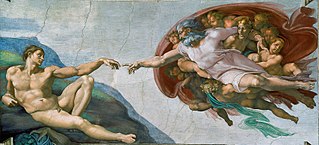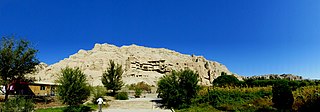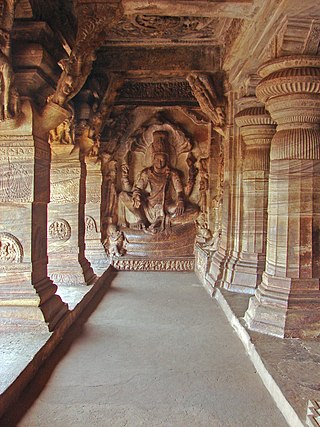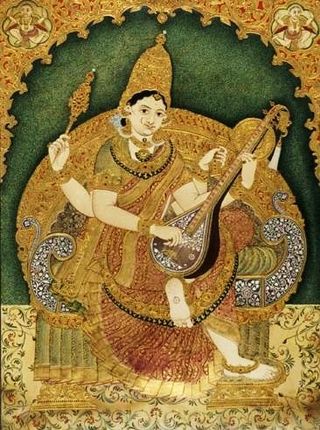
The Ajanta Caves are approximately thirty rock-cut Buddhist cave monuments dating from the second century BCE to about 480 CE in the Aurangabad district of Maharashtra state in India. The caves include paintings and rock-cut sculptures described as among the finest surviving examples of ancient Indian art, particularly expressive paintings that present emotions through gesture, pose and form.

Fresco is a technique of mural painting executed upon freshly laid ("wet") lime plaster. Water is used as the vehicle for the dry-powder pigment to merge with the plaster, and with the setting of the plaster, the painting becomes an integral part of the wall. The word fresco is derived from the Italian adjective fresco meaning "fresh", and may thus be contrasted with fresco-secco or secco mural painting techniques, which are applied to dried plaster, to supplement painting in fresco. The fresco technique has been employed since antiquity and is closely associated with Italian Renaissance painting. The word fresco is commonly and inaccurately used in English to refer to any wall painting regardless of the plaster technology or binding medium. This, in part, contributes to a misconception that the most geographically and temporally common wall painting technology was the painting into wet lime plaster. Even in apparently Buon fresco technology, the use of supplementary organic materials was widespread, if underrecognized.

Bonampak is an ancient Maya archaeological site in the Mexican state of Chiapas. The site is approximately 30 km (19 mi) south of the larger site of the people Yaxchilan, under which Bonampak was a dependency, and the border with Guatemala. While the site is not overly spatial or abundant in architectural size, it is well known for the murals located within the three roomed Structure 1. The construction of the site's structures dates to the Late Classic period. The Bonampak murals are noteworthy for being among the best-preserved Maya murals.

In archaeology, Cave paintings are a type of parietal art, found on the wall or ceilings of caves. The term usually implies prehistoric origin, and the oldest known are more than 40,000 years old and found in the caves in the district of Maros. The oldest are often constructed from hand stencils and simple geometric shapes. More recently, in 2021, cave art of a pig found in Sulawesi, Indonesia, and dated to over 45,500 years ago, has been reported.

The Mogao Caves, also known as the Thousand Buddha Grottoes or Caves of the Thousand Buddhas, form a system of 500 temples 25 km (16 mi) southeast of the center of Dunhuang, an oasis located at a religious and cultural crossroads on the Silk Road, in Gansu province, China. The caves may also be known as the Dunhuang Caves; however, this term is also used as a collective term to include other Buddhist cave sites in and around the Dunhuang area, such as the Western Thousand Buddha Caves, Eastern Thousand Buddha Caves, Yulin Caves, and Five Temple Caves. The caves contain some of the finest examples of Buddhist art spanning a period of 1,000 years. The first caves were dug out in AD 366 as places of Buddhist meditation and worship, later the caves became a place of pilgrimage and worship, and caves continued to be built at the site until the 14th century. The Mogao Caves are the best known of the Chinese Buddhist grottoes and, along with Longmen Grottoes and Yungang Grottoes, are one of the three famous ancient Buddhist sculptural sites of China.

Wu Daozi, also known as Daoxuan and Wu Tao Tzu, was a Chinese painter of the Tang dynasty. The British art historian Michael Sullivan considers him one of "the masters of the seventh century," Some of his works survive; many, mostly murals, have been lost.

The Kizil Caves are a set of Buddhist rock-cut caves located near Kizil Township in Baicheng County, Aksu Prefecture, Xinjiang, China. The site is located on the northern bank of the Muzat River 65 kilometres west of Kucha. This area was a commercial hub of the Silk Road. The caves have an important role in Central Asian art and in the Silk Road transmission of Buddhism, and are said to be the earliest major Buddhist cave complex in China, with development occurring between the 3rd and 8th centuries CE. The caves of Kizil are the earlier of their type in China, and their model was later adopted in the construction of Buddhist caves further east. Another name for the site has been Ming-oi, although this term is now mainly used for the site of Shorchuk to the east.

The Great Pyramid of Cholula, also known as Tlachihualtepetl, is a complex located in Cholula, Puebla, Mexico. It is the largest archaeological site of a pyramid (temple) in the New World, as well as the largest pyramid by volume known to exist in the world today. The adobe brick pyramid stands 25 metres (82 ft) above the surrounding plain, which is significantly shorter than the Great Pyramid of Giza's height of 146.6 metres (481 ft), but much wider, measuring 300 by 315 metres in its final form, compared to the Great Pyramid's base dimensions of 230.3 by 230.3 metres. The pyramid is a temple that traditionally has been viewed as having been dedicated to the god Quetzalcoatl. The architectural style of the building was linked closely to that of Teotihuacan in the Valley of Mexico, although influence from the Gulf Coast is evident as well, especially from El Tajín.

The Bezeklik Thousand Buddha Caves is a complex of Buddhist cave grottos dating from the 5th to 14th century between the cities of Turpan and Shanshan (Loulan) at the north-east of the Taklamakan Desert near the ancient ruins of Gaochang in the Mutou Valley, a gorge in the Flaming Mountains, in the Xinjiang region of western China. They are high on the cliffs of the west Mutou Valley under the Flaming Mountains, and most of the surviving caves date from the West Uyghur kingdom around the 10th to 13th centuries.

The Badami cave temples are a complex of Hindu and Jain cave temples located in Badami, a town in the Bagalkot district in northern part of Karnataka, India. The caves are important examples of Indian rock-cut architecture, especially Badami Chalukya architecture, and the earliest date from the 6th century. Badami is a modern name and was previously known as Vataapinagara, the capital of the early Chalukya dynasty, which ruled much of Karnataka from the 6th to the 8th century. Badami is situated on the west bank of a man-made lake ringed by an earthen wall with stone steps; it is surrounded on the north and south by forts built in later times. These caves were discovered by Stella Kramrisch in 1924.

The Sarcophagi of Carajía are unusually large pre-Inca Chachapoyas culture sarcophagi at the archaeological site of Carajía in the Utcubamba Valley, located 48 km northwest of the city of Chachapoyas, Peru in Luya Province, Amazonas Region. The site contains eight Chachapoyan mummies located on a cliffside, referred to by local residents as the “ancient wise men”.

The Revash funerary complex is located in Peru's Santo Tomás District, part of Luya Province, which is approximately 60 km to the south of Chachapoyas. The funeral buildings are located at an altitude of 2,800 m above sea level. They are within the calcareous rock formation of Cerro Carbón, located in the margin left side of the vale of Alto Utcubamba. The San José de Laumar River serves as the Southeastern border.

Mysore painting is an important form of classical South Indian painting style that originated in and around the town of Mysore in Karnataka encouraged and nurtured by the Mysore rulers. Painting in Karnataka has a long and illustrious history, tracing its origins back to the Ajanta times The distinct school of Mysore painting evolved from the paintings of Vijayanagar times during the reign of the Vijayanagar Kings The rulers of Vijayanagar and their feudatories encouraged literature, art, architecture, religious and philosophical discussions. With the fall of the Vijayanagar empire after the Battle of Talikota the artists who were till then under royal patronage migrated to various other places like Mysore, Tanjore, Surpur, etc. Absorbing the local artistic traditions and customs, the erstwhile Vijayanagar School of Painting gradually evolved into the many styles of painting in South India, including the Mysore and Tanjore schools of painting.

Oxtotitlán is a natural rock shelter and archaeological site in Chilapa de Álvarez, Mexican state of Guerrero that contains murals linked to the Olmec motifs and iconography. Along with the nearby Juxtlahuaca cave, the Oxtotitlán rock paintings represent the "earliest sophisticated painted art known in Mesoamerica", thus far. Unlike Juxtlahuaca, however, the Oxtotitlán paintings are not deep in a cave system but rather occupy two shallow grottos on a cliff face.

Master Theodoric, in Latin Magister Theodoricus was a Bohemian painter. He is the best documented Bohemian Gothic painter. He was the favourite court painter of Charles IV, Holy Roman Emperor. and the first Bohemian painter whose name can be linked to a body of work. Theodoric is considered the chief representative of the phase of International Gothic known as "the Soft style". His masterpiece is the Chapel of the Holy Cross at Charles' newly completed Karlštejn Castle, near Prague, containing a large series of slightly over-lifesize half-length panel portraits of saints and other notable figures on a gold ground. The whole decoration of the chapel was commissioned in 1359 and completed over a number of years. The decoration of the Chapel of the Holy Cross was unique and unprecedented at the north of the Alps. Theodoric's oeuvre is not comparable to anything in European art after the mid-14th century (1360th).

Painting in the Americas before European colonization is the Precolumbian painting traditions of the Americas. Painting was a relatively widespread, popular and diverse means of communication and expression for both religious and utilitarian purpose throughout the regions of the Western Hemisphere. During the period before and after European exploration and settlement of the Americas; including North America, Central America, South America and the islands of the Caribbean, the Bahamas, the West Indies, the Antilles, the Lesser Antilles and other island groups, indigenous native cultures produced a wide variety of visual arts, including painting on textiles, hides, rock and cave surfaces, bodies especially faces, ceramics, architectural features including interior murals, wood panels, and other available surfaces. Many of the perishable surfaces, such as woven textiles, typically have not been preserved, but Precolumbian painting on ceramics, walls, and rocks have survived more frequently.

The group of over 700 sites of prehistoric Rock art of the Iberian Mediterranean Basin, also known as Levantine art, were collectively declared a World Heritage Site by UNESCO in 1998. The sites are in the eastern part of Spain and contain rock art dating to the Upper Paleolithic or Mesolithic periods of the Stone Age. The art consists of small painted figures of humans and animals, which are the most advanced and widespread surviving from this period, certainly in Europe, and arguably in the world, at least in the earlier works. It is notable for the number of places included, the largest concentration of such art in Europe. Its name refers to the Mediterranean Basin; however, while some sites are located near the sea, many of them are inland in Aragon and Castilla–La Mancha; it is also often referred to as Levantine Art.

The Sanctuary of Atotonilco is a church complex and part of a World Heritage Site, designated along with nearby San Miguel de Allende, Guanajuato, Mexico. The complex was built in the 18th century by Father Luis Felipe Neri de Alfaro, who, according to tradition, was called upon by a vision of Jesus with a crown of thorns on his head with blood on his face and carrying a cross. The main feature of the complex is the rich Mexican Baroque mural work that adorns the main nave and chapels. This was chiefly the work of Antonio Martínez de Pocasangre over a period of thirty years. The mural work has led the complex to be dubbed the "Sistine Chapel of Mexico." The complex remains a place of worship and penance to this day, attracting as many as 5,000 visitors every week.

The Black Paintings is the name given to a group of 14 paintings by Francisco Goya from the later years of his life, likely between 1819 and 1823. They portray intense, haunting themes, reflective of both his fear of insanity and his bleak outlook on humanity. In 1819, at the age of 72, Goya moved into a two-story house outside Madrid that was called Quinta del Sordo. Although the house had been named after the previous owner, who was deaf, Goya too was nearly deaf at the time as a result of an unknown illness he had suffered when he was 46. The paintings originally were painted as murals on the walls of the house, later being "hacked off" the walls and attached to canvas by owner Baron Frédéric Émile d'Erlanger. They are now in the Museo del Prado in Madrid.

Fernando Leal was one of the first painters to participate in the Mexican muralism movement starting in the 1920s. After seeing one of his paintings, Secretary of Education José Vasconcelos invited Leal to paint at the Escuela Nacional Preparatoria. The resulting work is Los danzantes de Chalma. Leal also painted a mural dedicated to Simón Bolívar at the Anfiteatro Bolivar, as well as religious murals such as those at the chapel dedicated to the Virgin of Guadalupe at the Basilica Villa in Tepeyac.




















